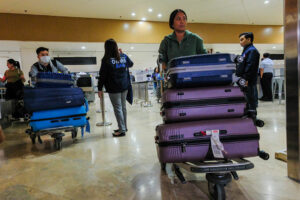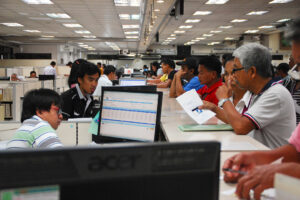REMITTANCE inflows to the Philippines may fall by 1.4% if US President Donald J. Trump’s proposed tax on money sent home by foreign workers is implemented, Deutsche Bank Research said.
In a June 20 note, Deutsche Bank Research said Philippine remittances have been “sluggish” in recent months and face more downside risks if the so-called “One Big Beautiful Bill” is signed into law in the US.
“The imposition of such a tax in the US could lead to a 1.4% decline in remittance inflow (0.1% of gross domestic product) to the Philippines,” it said.
“However, we believe that the impact of a tax on remittances is likely to be short-lived; structural shifts are more likely to affect the growth of remittances in the longer term.”
Mr. Trump is pushing for the passage of the “One Big Beautiful Bill,” which includes a provision imposing an excise tax of 3.5% on money sent abroad by foreign workers in the US. Remittances made by US citizens and nationals are exempted from the tax.
The bill was approved by the US House of Representatives in May, and is now being deliberated by the Senate.
Deutsche Bank Research noted the US makes up 41% of total remittance inflows to the Philippines.
In 2024, cash remittances jumped by 3% to $34.49 billion from the $33.49 billion registered in 2023. The US was the top country source of remittances, accounting for 40.6% of the total.
“However, we note that this could be an overestimate of the remittances that originate from within the US,” it said.
It noted that North and South America account for only 9.8% of overseas Filipino workers (OFWs), while the Middle East accounts for around half or 46% of all OFWs.
“While a remittance shock could weigh on the Philippines’ current account balance and household consumption in the short term, we argue that structural shifts in OFWs would influence longer-term trends in remittances to a greater extent,” Deutsche Bank Research said.
The deployment of OFWs has declined since the coronavirus disease 2019 (COVID-19) pandemic. Deutsche Bank Research noted the share of households with OFWs fell to 6.5% after the pandemic, as many OFWs opted to stay in the Philippines instead of working abroad again.
“This could partly explain why remittance growth post-COVID has been lower at ~3% year on year on average vs. 5.8% in the 2010s. Remittances also fell to 7.7% of gross domestic product during the same period from 8.4% prior to that,” it said.
Cash remittances from migrant Filipinos coursed through banks rose by 4% to $2.66 billion in April from $2.56 billion in the same month a year ago.
In the first four months of 2025, cash remittances went up by 3% to $11.11 billion annually from $10.78 billion a year ago.
“In the short term, remittances should remain a crucial source of funding for the Philippines, but push-pull factors make the long term more uncertain,” Deutsche Bank Research said.
It noted there could be increased demand for Filipino healthcare workers in countries with aging populations.
“On the other hand, continued growth of the domestic BPO (business process outsourcing) industry could lead to OFWs in the foreign BPO sector to choose to relocate back to the Philippines,” it said.
The BSP forecasts 2.8% growth in cash remittances to an estimated $35.5 billion this year. Next year, cash remittances are projected to grow by 3% to $36.5 billion. — A.R.A.Inosante





